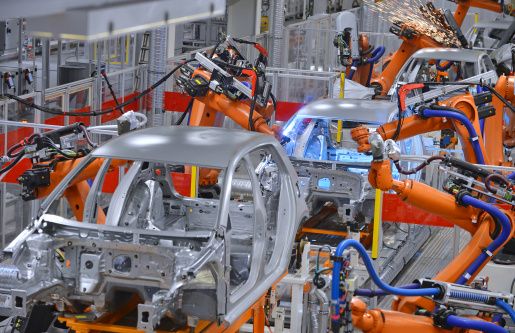 Toyota says the new manufacturing concept will allow them to build better-quality vehicles while also reducing costs and improving efficiency.
Toyota says the new manufacturing concept will allow them to build better-quality vehicles while also reducing costs and improving efficiency.
Toyota’s new plant will be its first major production expansion plan in three years, according to the Wall Street Journal. The proposed facility in Guanajuato, Mexico, will employ approximately 2,000 workers and will produce roughly 200,000 Corollas per year for the North American market. Jim Lentz, CEO of Toyota North America, said in a company statement that the next-generation facility will be a model for the future of global manufacturing and will set a “new standard for innovation and excellence.”
The Guanajuato facility will be the first to be constructed from the ground-up to embrace the Toyota New Global Architecture. TNGA uses a revolutionary process that designs, engineers, and manufacturers vehicles in a streamlined process with standardized size and positioning of key components in vehicle platforms. Toyota says this standardization at an early stage will increase efficiency and reduce production times. Automotive News says its a “radical change” in auto manufacturing for a company that typically doesn’t change its manufacturing process.
Toyota says the TNGA process will allow for smaller, more flexible factories that can accommodate multiple models, even on the same line. Toyota also says that the sharing of components among different vehicles will reduce the number of parts needed and will reduce manpower needs by 20%.
Toyota has been engaged in “meticulous planning” with suppliers for years to ensure that they’re in harmony with the concept when it launches, Automotive News reports. Toyota will soon launch its first TNGA vehicle in North America at the plant in Georgetown, Ky., with a seasoned workforce so it can work out the logistics for the new system. The company will then start TNGA production in Mexico in 2019.
“We’re learning the capability of how to launch this in the Midwest. We’ll take those learning points and apply them to Mexico. So from a risk standpoint, we think we can manage it,” said Robert Young, Toyota’s North American senior vice president for purchasing, told Automotive News.
Young said they had a tremendous amount of “go-and-see” with suppliers in Mexico to align their schedules and create the best design solutions to allow them to optimize the manufacturing process within their supplier’s facilities. Part of what makes Toyota’s new manufacturing concept so unique is that the company is relying on their suppliers to help build the supply end.
“We’re asking our suppliers to rethink their entire process, whether it’s the production and engineering team, the conveyance and logistics team—whatever it might be—to rethink some of their legacy methodology and come up with the best solutions for TGNA,” said Young.
Toyota is joining a number of other auto manufacturers that are building assembly plants in Mexico. Since 2013, seven other European, Asian, and American automakers, including Ford, General Motors, Kia, and Hyundai, have either begun production or announced plans to do so in Mexico. Mexican government officials say these automakers have invested more than $21 billion in the country in the past two years. All combined, Mexico produced more than 3 million light vehicles in 2014, making it the world’s seventh largest auto manufacturing country. Eighty percent of the vehicles are exported, mostly to the U.S. market.

Chief Executive Group exists to improve the performance of U.S. CEOs, senior executives and public-company directors, helping you grow your companies, build your communities and strengthen society. Learn more at chiefexecutivegroup.com.
0

1:00 - 5:00 pm
Over 70% of Executives Surveyed Agree: Many Strategic Planning Efforts Lack Systematic Approach Tips for Enhancing Your Strategic Planning Process
Executives expressed frustration with their current strategic planning process. Issues include:
Steve Rutan and Denise Harrison have put together an afternoon workshop that will provide the tools you need to address these concerns. They have worked with hundreds of executives to develop a systematic approach that will enable your team to make better decisions during strategic planning. Steve and Denise will walk you through exercises for prioritizing your lists and steps that will reset and reinvigorate your process. This will be a hands-on workshop that will enable you to think about your business as you use the tools that are being presented. If you are ready for a Strategic Planning tune-up, select this workshop in your registration form. The additional fee of $695 will be added to your total.

2:00 - 5:00 pm
Female leaders face the same issues all leaders do, but they often face additional challenges too. In this peer session, we will facilitate a discussion of best practices and how to overcome common barriers to help women leaders be more effective within and outside their organizations.
Limited space available.

10:30 - 5:00 pm
General’s Retreat at Hermitage Golf Course
Sponsored by UBS
General’s Retreat, built in 1986 with architect Gary Roger Baird, has been voted the “Best Golf Course in Nashville” and is a “must play” when visiting the Nashville, Tennessee area. With the beautiful setting along the Cumberland River, golfers of all capabilities will thoroughly enjoy the golf, scenery and hospitality.
The golf outing fee includes transportation to and from the hotel, greens/cart fees, use of practice facilities, and boxed lunch. The bus will leave the hotel at 10:30 am for a noon shotgun start and return to the hotel after the cocktail reception following the completion of the round.